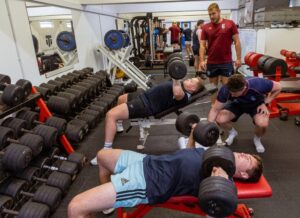As part of our Rugby Proof Renegade series we introduce our hamstring prehab, perfect for the offseason or integrated into your lower body program. Eccentric exercises will hold a core role in this program, with strong evidence demonstrating that eccentrics are beneficial in reducing hamstring injury rates.
Despite endless research and programs hamstrings strains and tears are still one of the most common injuries in running based field sports. The reason for this is that the hamstrings are one of the key force producers and force distributors in the lower limb when running at high speed. Like most of the muscles and joints in the body covering the fundamentals of strength, range of movement and the ability to control both underpin every injury prevention strategy.
The hamstrings are a group of three muscles, the biceps femoris that sits on the outside (lateral) of the posterior thigh and the semi-tendinosis and semi-membranosis that sit on the inside (medial) part of the posterior thigh. They work together but the bicep femoris is relatively more active during maximal sprints and the medial hamstrings are more active during cutting and acceleration and deceleration activities. Like all physical activities there is a complex interaction between multiple nerves, muscles, joints, ligaments and tendons. In the case of the hamstrings they work closely with the adductors, muscles of the hip, lower back, lower leg and stabilisers of the trunk. It is important to remember that this program will focus on the hamstrings but it will be no substitute for a strong and mobile trunk, hip, lower limb, foot and ankle. Future injury prevention programs will focus on these areas and the well rounded Rugby Renegade program allows you to develop good movement fundamentals across the board.
You will notice that we haven’t included a lot of mobility for the hamstrings. Of course it’s important to mobilise and mobility work can make up a large part of a recovery strategy but we want your hamstrings to be strong and to be active. Thats why the example exercises focus far more on activation. This has been done deliberately as we very rarely find that people who have hamstring issues have shortened hamstrings that need to be religiously stretched. What we find is far more common is that they hamstrings are in a poor position or even more likely that they are overloaded due to poor mechanics, poor training planning or strength deficits elsewhere in the body. Once youe taken a look at our injury prevention exercises make sure you read the other injury prevention articles so you can be truly Rugby Proof!
Our exercise demos are designed to help educate you. They’re not to take the place of a proper physio assessment. If you need a full training program then take a look at ourmembers area – daily training sessions and dedicated injury prevention content and programs for you to work through too.
We’ve included some useful hamstring exercise demos for you here but you can find the full list on in our YouTube playlist. We’re always adding to our library so make sure you subscribe to the channel and our email list so you can stay up to date with all of our content.




